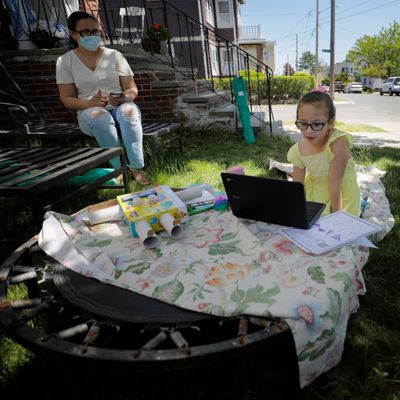
Women more often do two things at once, sociologist Arlie Russell Hochschild found in 1989. They “write checks and return phone calls, vacuum and keep an eye on the 3-year-old, fold laundry and think out the shopping list,” she wrote in The Second Shift. The tasks add up, and so does the stress. As Hochschild pursued her research, she arrived at an unfortunate conclusion. Mothers typically worked the equivalent of two jobs: one in public and another in the private domestic sphere of the home. She warned the gender revolution was potentially stalled. Now the gender revolution may no longer be stalled — it may be in reverse.
Blame some backward momentum on the pandemic. Nearly 3 million women left the workforce in 2020, and only 1.5 million had returned by late April of this year. Schools closed, which forced children home and increased burdens on women again to look after them. While nearly half of fathers told the New York Times that they did most of the homeschooling, only 3 percent of mothers agreed with their version of events. Eighty percent said they — not fathers — did most of the homeschooling, and 70 percent said they did most of the housework, too. This is a crisis, most agree — but not all. If the pandemic did create a nation of housewives, it has blessed the religious right. Somewhere beyond the grave, Phyllis Schlafly must be pleased.
Her modern successors have to hide their obvious pleasure. Gone are the days when a conservative could speak openly of a woman’s gentle nature, or her submissive qualities, or her intrinsic desire to stay in the home. The religious right has never been totally at ease with women’s march through the institutions, and the pandemic grants them a precious opportunity that President Biden is trying to spoil. His American Families Plan would raise taxes on the rich to entirely cover child-care costs for low-income workers and ensure other workers would only have to spend a set portion of their income on child care. Families with 3- and 4-year-old children could take advantage of universal preschool, an option that now exists only in some municipalities, like New York. The policies aren’t quite universal child care, but Biden’s policies would still be consequential. Child care would become less of a luxury service and more of a right. That’s good for women and children too, the Biden administration believes, and so do many experts.
Yet the plan has its detractors. At The Week, commentator Bonnie Kristian argued that Biden’s plan to ease the parental path to work is “not what most lower-income and working-class Americans want.” Taking matters a step further in a Wall Street Journal editorial, Hillbilly Elegy author and probable Senate candidate J.D. Vance elaborated on tweets that called the concept of universal child care “a massive subsidy to the lifestyle preferences of the affluent over the preferences of the middle and working class.” In the piece, which he co-wrote with Jenet Erickson, a policy analyst at the conservative Institute for Family Studies, Vance called the proposal “a bad deal for American children” and cited research that attributed negative social outcomes to early years spent in subsidized Quebec day-care programs. High-quality day care might be good for kids from troubled homes, they concede, but children from “average, healthy homes” might be harmed. “Our democracy might be comfortable with the trade-offs here … But we ought to be honest and acknowledge that these trade-offs exist,” they wrote.
Honesty is indeed a virtue, so here is the truth. According to a new Morning Consult poll, the American Families Plan is popular with voters, and most say they support Biden’s family-care provisions. Thus far, there doesn’t seem to be a populist groundswell against the notion of subsidized day care. And if working women do inflict unspeakable damage on their children, feminists would have to search their souls. My own future would reorient around new questions. No longer would I wonder at the cost of day care. I’d ask myself if I’m ready to abandon my career to have my children. (The blunt answer is that I’m not and never would be.) Sure, my partner could stay home instead — but that’s not really what Vance, his co-editorialist, or anyone else who’s railing against Biden’s child-care proposal really wants. The world hasn’t changed so drastically since Hochschild originally published her groundbreaking work. Women made fragile progress. Without universal day care, they’re most likely the parent who is forced to stay home.
“Trade-offs,” as Vance and Erickson call them, don’t just keep women home: They’re also unnecessary. The Quebec study they cite “wasn’t set up to establish causality” between time in child care and negative outcomes later, said Dr. Jessica Bartlett, a program director for Child Trends, a research organization. “It’s always possible to find negative effects of poor-quality care on children,” Bartlett told Intelligencer. “That never surprises me when that is a finding, because that to me speaks to the argument to provide child care that is of good quality.” The idea that high-quality child care is good for disadvantaged children but negative for children from strong homes is “a hypothesis,” and she could recall no research that would back up the claim. “I just feel like it’s important to say really strongly that this is our reality,” she added. “Parents need child care. So it’s in our own best interest to provide them with the highest-quality comprehensive care we can.”
Why, then, are some on the right so eager for one parent to stay home? The pandemic isn’t the only force propelling women out of the workforce. No woman makes a child by herself. Someone still has to answer the phone and vacuum the house and fold the laundry, and that someone is usually a woman. In her 2012 afterword to the revised edition of The Second Shift, Hochschild wrote that circumstances for women have improved. Men have become much more willing to pick up chores and help with children. Yet the second shift persists. Where women once worked an extra month a year in household labor, research published in 2009 shows they were working an extra two weeks. It took women 25 years to cut the second shift in half, she observed. The backlash against day care largely concerns the choices of women, but men deserve equal scrutiny. If men pulled their weight, before the pandemic and during, the day-care debate would have different stakes.
Men so obviously influence women’s relationship to work that it bears asking why more interlocutors don’t consider them. The answer combines gender and class. Vance and Erickson cite an American Compass survey also referenced by Kristian at The Week. They reached similar conclusions: The working class doesn’t want universal day care. Only wealthy elites, with their college degrees and their unhealthy propensity to work overtime, say they want their children in day care full time while both parents work. Vance’s class arguments are also tenuous. Though he attacked “universal childcare” on Twitter, Biden’s plan is not that; it only subsidizes day care for low- and middle-income families. It’s hardly some giveaway to the rich. Vance and Erickson can argue, based on one survey, that poorer families tend to prefer cash payments, but this isn’t proof that subsidized or universal child care is somehow anti-poor.
While Vance and his ilk rail against the elites, they fashion themselves outsiders. The truth is a lot sillier. Vance is a venture capitalist and best-selling author who went to Yale Law School. He is an elite, and so is Senator Josh Hawley, whose parental tax credit he and Erickson cite approvingly in their editorial. Elites like Vance and Hawley can already afford child care; it’s easy to oppose solutions you don’t need. They defend a structure that directly benefits them. The way we work was constructed around the choices and preferences of men, another Hochschild observation that still resonates. Though women have always worked for a wage, they do so in a system that wasn’t built by them or for them. Even well-off women can be trapped by it. A professional man’s career is possible, often, because of his wife and the choices she makes to support him.
The Hawley tax credit would only reinforce that dynamic. He suggests giving an annual tax credit worth $6,000 to single parents and a tax credit worth $12,000 to married parents. This “guarantees that married parents are not penalized if one parent chooses to stay home to care for their children,” Hawley explained in a piece for Fox Business. That’s not much of a choice: $12,000 won’t fully pay child-care costs, but it does pay a parent a poverty wage to stay home. In keeping with the long history of gender, the parent making that poverty wage will almost certainly be a woman deprived both of an adequate living and of the opportunity to pursue a career.
A career isn’t everything, it’s true. Give parents the option to work part time and stay home with their children without going hungry and many will probably choose it. The reasons are no great mystery. But to truly end workism, as Vance and Erickson say they want, will take more than the Hawley tax credit. Parents need a real choice, which is what universal day care offers them. Combine that proposal with a permanent child or dependent allowance, and parents would have the flexibility that the system currently denies them. Nobody can reimagine work or her relationship to it without the universal programs that the right opposes, and that is a clarifying fact. The backlash to day care is not about workism but women.






























